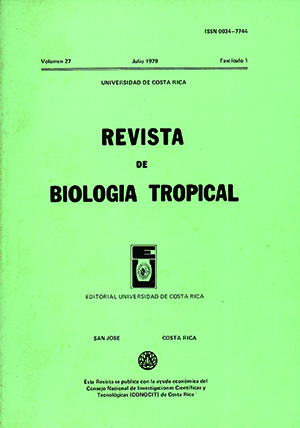Resumen
Este estudio ofrece descripciones de los nidos e información sobre los ciclos estacionales y sobre el comportamiento social de cuatro abejas halíctidas, Habralictus bimaculatus, Caenohalictus eberhardorum, Lasioglossum (Dialictus) seabrai. y L. (D.) breedi. También se incluyen datos sobre dos halíetidos parásitos, ambos del género Microsphecodes. Las especies Habralictus y Caenohalictus nidifican en agregaciones y los nidos individuales son ocupados por una o por varias abejas. No hay castas y dentro de un nido con dos o más abejas las relaciones son comunales o posiblemente cuasisociales. Las dos especies de Lasioglossum (Dialictus) nidifican en agregaciones a menudo disperas y pequeñas. Las colonias tienen un promedio de poco más de dos abejas, y hay reinas y obreras que se diferencian muy poco de las demás, especialmente en L. seabrai. Las actividades de las abejas parecen ser iguales durante la estación seca y la lluviosa.
Citas
Batra, S. W. T. 1966. The life cycle and behavior of the primitively social bee, Lasioglossum zephyrum (Halictidae), Kansas Univ. Sci. Bull., 46: 359-423.
Breed, M. D. 1975. Life cycle and behavior of a primitively social bee, Lasioglossum rohweri (Hymenoptera: Halictidae). J. Kansas Ent. Soc., 64-80.
Deeed, M. D. 1976. The evolution of social behavior in primitively social bees: a multivariale analysis. Evolution, 30: 234-240.
Claude-Joseph, F. 1962. Recherches biologique sur les Hyménopteres du Chili (Melliferes). Ann. Sci. Nat., Zool, (10) 9: 113-268. [Translated by M. Etcheverry and A. Valenzuela into Spanish as: Investigaciones biológicas sobre himenópteros de Chile (Melíferos) de Claude Joseph. Publ. del Centro de Estudios Entomológicos, Univ. de Chile, No. 1: 1-60, pls. 1-18.
Eickwort, G. C., & K. R. Eickwort. 1972. Aspects of the biology of Costa Rican halictine bees, III. Sphecodes kathleenoe, a social cleptoparasite of Dialictus umbripennis (Hymenoptera: Halictidae). J. Kansas Ent. Soc., 45: 529-541.
Litte, M. 1977. Aspects of the social biology of the bee Halictus ligatus in New York State (Hymenoptera, Halietidae). Insectes Sociaux, 24: 9-36.
Michener, C. D. 1974. The social behavior of the bees. Harvard Univ. Press.
Michener, C. D. 1977a. Aspects of the evolution of castes in primitively social insects. Proc. 8th Internal. Congr., Internat. Union Stud. Soc. Insects (Wageningen, Netherlands), p. 2-6.
Michener, C. D. 1977b. Nests and seasonal cycle of Neocorynura pubescens in Colombia. Rev. Biol. Trop., 25, 39-41.
Michener, C. D. 1978. The parasitic groups of Halictidae (Hymenoptera, Apoidea). Kansas Univ. Sci. Bull., 51, 291-339.
Michener, C. D. 1979. New and little-known halictine bees from Colombia (Hymenoptera: Halictidae). J. Kansas Ent. Soc., 52: 180-208.
Michener, C. D., & F. D. Bennett. 1977. Geographical variation in nesting biology and social organization of Halictus ligatus. Kansas Univ. Sci. Bull., 51: 233-260.
Michener, C. D., D. J. Brothers, & D. R. Kamm. 1971. Interactions in colonies of primitively social bees: artificial colonies of Lasioglossum zephyrum. Proc. Nat. Acad. Sci. Wash., 68: 1241-1245.
Michener, C. D., E. A. Cross, H. V. Daly, C. W. Rettenmeyer, & A. Wille. 1955. Additional techniques for studying the behavior of wild bees. Insectes sociaux, 2: 237-246.
Michener, C. D. & R. B. Lange. 1958. Observations on the behavior of Brazilian halictid bees. III. Kansas Univ. Sci. Bull., 39: 473-505.
Michener, C. D., & C. A. C. Seabra. 1959. Observations on the behavior of Brazilian halictid bees. VI. Tropical species. J. Kansas Ent. Soc., 32: 19-28.
Michener, C. D., & A. Wille. 1961. The bionomics of a primitively social bee, Lasioglossum incollspicuum. Kansas Univ. Sci. Bull., 42: 1123-1202.
Platcaux-Quénu, C. 1959. Un novcau type de société d'insectes: Halictus marginatus Brullé. Ann. Biol., 35: 235-444, pls. I-IX.
Sakagami, S. F., & C. D. Michener. 1962. The nest architecture of the sweat bees. Univ. Kansas Press, Lawrence, Kansas.
Sakagami, S. F., & J. S. Moure. 1967. Additional observations on the nesting habits of some Brazilian halictine bees. Mushi, 40: 119-138.
##plugins.facebook.comentarios##

Esta obra está bajo una licencia internacional Creative Commons Atribución 4.0.
Derechos de autor 1979 Revista de Biología Tropical


